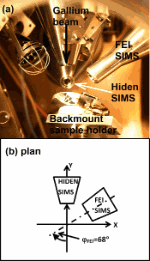Richard J. Chater1, a), Alan J. Smith2 and Graham Cooke2
1 Department of Materials, Imperial College of Science, Technology and Medicine, London SW7 2AZ, United Kingdom
2 Hiden Analytical Ltd, Warrington WA5 7UN, United Kingdom
A secondary ion mass spectrometer (SIMS) instrument is described that is configured with two SIMSdetectors that are both low-field extraction, quadrupole-based filters. Secondary ions are generated by sputtering with a liquid-metal ion gallium source and column of the type that is common on two-beam electron microscopes. The gallium ion beam, or focused ion beam achieves sub-100 nm focus with a continuous current of up to 300 pA. Positive secondary ions are detected by one SIMSdetector, and simultaneously, negative secondary ions are detected by the second SIMSdetector. The SIMSdetectors are independently controlled for recording mass spectra, concentration depth profiles, and secondary ion images. Examples of simultaneous positive and negative SIMS are included that demonstrate the advantage of this facility for surface analysis and depth profiling. The SIMS secondary ion collection has been modeled using the ray tracing program simion (“simion”, Scientific Instrument Services, Inc., Ringoes, NJ, 08551-1054, see http://www.simion.com) in order to understand the interaction of the secondary ions of opposite polarities in the extraction volume for the purpose of optimizing secondary ion collection.

Fig. 1. (Color online) Configuration of the two SIMS detectors, gallium primary ion column, and back-mount sample holder is shown in the photograph (a) and the schematic plan (b). The X, Y directions are the axes of the sample stage, and the origin is the gallium primary ion impact point at the eucentric height on the Z-axis that is perpendicular to the XY plane through the origin. The distances from the origin to the front of the FEI detector is 18 mm and to the Hiden detector is 15 mm. The tilt angles for the two detectors seen in (a) above the XY plane are αHiden = 19° and αFEI = 35°.
J. Vac. Sci. Technol. B 34, 03H122 (2016); http://dx.doi.org/10.1116/1.4943531
Visit Product Page : EQS
View Article Online : Simultaneous detection of positive and negative secondary ions
Make an enquiry : Send us a message

